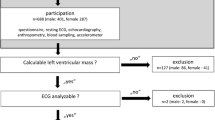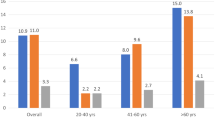Abstract
Background
Left ventricular hypertrophy (LVH) is an independent risk factor for cardiovascular disease and is associated with heart failure development. The Cornell product is an easily measured electrocardiographic parameter for assessing LVH. However, it is undetermined whether the Cornell product can predict the cardiac prognosis of chronic heart failure (CHF) patients.
Methods and results
We performed standard 12-lead electrocardiography and calculated the Cornell product in 432 consecutive CHF patients. LV geometry was assessed as normal, concentric remodeling, concentric or eccentric hypertrophy. The Cornell product was significantly higher in patients with eccentric hypertrophy, and increased with advancing New York Heart Association functional class. During a median follow-up of 660 days, there were 121 cardiac events including 36 cardiac deaths and 85 re-hospitalizations for worsening heart failure. Multivariate Cox proportional hazard analysis showed that the Cornell product was an independent predictor of cardiac events in CHF patients. Patients in the highest quartile of Cornell product had a higher prevalence of LV eccentric hypertrophy (22, 29, 33 and 67 % for quartiles one through four). Kaplan–Meier analysis demonstrated that the highest quartile of Cornell product was associated with the greatest risk among CHF patients.
Conclusion
The Cornell product is associated with LV eccentric hypertrophy and can be used to predict future cardiac events in CHF patients.




Similar content being viewed by others
References
Lloyd-Jones DM, Larson MG, Leip EP, Beiser A, D’Agostino RB, Kannel WB, Murabito JM, Vasan RS, Benjamin EJ, Levy D (2002) Lifetime risk for developing congestive heart failure: the Framingham Heart Study. Circulation 106(24):3068–3072
McMurray JJ, Petrie MC, Murdoch DR, Davie AP (1998) Clinical epidemiology of heart failure: public and private health burden. Eur Heart J 19(Suppl P):P9–P16
Franke J, Zugck C, Wolter JS, Frankenstein L, Hochadel M, Ehlermann P, Winkler R, Nelles M, Zahn R, Katus HA, Senges J (2012) A decade of developments in chronic heart failure treatment: a comparison of therapy and outcome in a secondary and tertiary hospital setting. Clin Res Cardiol 101(1):1–10. doi:10.1007/s00392-011-0348-6
Molloy TJ, Okin PM, Devereux RB, Kligfield P (1992) Electrocardiographic detection of left ventricular hypertrophy by the simple QRS voltage-duration product. J Am Coll Cardiol 20(5):1180–1186
Okin PM, Roman MJ, Devereux RB, Kligfield P (1996) Electrocardiographic identification of left ventricular hypertrophy: test performance in relation to definition of hypertrophy and presence of obesity. J Am Coll Cardiol 27(1):124–131. doi:10.1016/0735-1097(95)00421-1
Shamim W, Francis DP, Yousufuddin M, Varney S, Pieopli MF, Anker SD, Coats AJ (1999) Intraventricular conduction delay: a prognostic marker in chronic heart failure. Int J Cardiol 70(2):171–178
Kashani A, Barold SS (2005) Significance of QRS complex duration in patients with heart failure. J Am Coll Cardiol 46(12):2183–2192. doi:10.1016/j.jacc.2005.01.071
Kannel WB (1991) Left ventricular hypertrophy as a risk factor: the Framingham experience. J Hypertens Suppl 9(2):S3–S8 discussion S8–S9
Lok DJ, Lok SI, Bruggink-Andre de la Porte PW, Badings E, Lipsic E, van Wijngaarden J, de Boer RA, van Veldhuisen DJ, van der Meer P (2013) Galectin-3 is an independent marker for ventricular remodeling and mortality in patients with chronic heart failure. Clin Res Cardiol 102(2):103–110. doi:10.1007/s00392-012-0500-y
De Keulenaer GW, Brutsaert DL (2007) Systolic and diastolic heart failure: different phenotypes of the same disease? Eur J Heart Fail 9(2):136–143. doi:10.1016/j.ejheart.2006.05.014
Doi R, Masuyama T, Yamamoto K, Doi Y, Mano T, Sakata Y, Ono K, Kuzuya T, Hirota S, Koyama T, Miwa T, Hori M (2000) Development of different phenotypes of hypertensive heart failure: systolic versus diastolic failure in Dahl salt-sensitive rats. J Hypertens 18(1):111–120
Wachtell K, Okin PM, Olsen MH, Dahlof B, Devereux RB, Ibsen H, Kjeldsen SE, Lindholm LH, Nieminen MS, Thygesen K (2007) Regression of electrocardiographic left ventricular hypertrophy during antihypertensive therapy and reduction in sudden cardiac death: the LIFE Study. Circulation 116(7):700–705. doi:10.1161/circulationaha.106.666594
Sundstrom J, Lind L, Arnlov J, Zethelius B, Andren B, Lithell HO (2001) Echocardiographic and electrocardiographic diagnoses of left ventricular hypertrophy predict mortality independently of each other in a population of elderly men. Circulation 103(19):2346–2351
Okin PM, Devereux RB, Harris KE, Jern S, Kjeldsen SE, Julius S, Edelman JM, Dahlof B (2007) Regression of electrocardiographic left ventricular hypertrophy is associated with less hospitalization for heart failure in hypertensive patients. Ann Intern Med 147(5):311–319
Bender SR, Friedman DJ, Markowitz SM, Lerman BB, Okin PM (2012) Electrocardiographic left ventricular hypertrophy predicts arrhythmia and mortality in patients with ischemic cardiomyopathy. J Interv Card Electrophysiol. doi:10.1007/s10840-011-9661-2
McKee PA, Castelli WP, McNamara PM, Kannel WB (1971) The natural history of congestive heart failure: the Framingham study. N Engl J Med 285(26):1441–1446. doi:10.1056/nejm197112232852601
Rodrigues SL, Angelo LC, Baldo MP, Dantas EM, Barcelos AM, Pereira AC, Krieger JE, Mill JG (2013) Detection of left ventricular hypertrophy by the R-wave voltage in lead aVL: population-based study. Clin Res Cardiol 102(9):653–659. doi:10.1007/s00392-013-0578-x
Levy D, Savage DD, Garrison RJ, Anderson KM, Kannel WB, Castelli WP (1987) Echocardiographic criteria for left ventricular hypertrophy: the Framingham Heart Study. Am J Cardiol 59(9):956–960
Muiesan ML, Salvetti M, Monteduro C, Bonzi B, Paini A, Viola S, Poisa P, Rizzoni D, Castellano M, Agabiti-Rosei E (2004) Left ventricular concentric geometry during treatment adversely affects cardiovascular prognosis in hypertensive patients. Hypertension 43(4):731–738. doi:10.1161/01.HYP.0000121223.44837.de
Ganau A, Devereux RB, Roman MJ, de Simone G, Pickering TG, Saba PS, Vargiu P, Simongini I, Laragh JH (1992) Patterns of left ventricular hypertrophy and geometric remodeling in essential hypertension. J Am Coll Cardiol 19(7):1550–1558
Matsuo S, Imai E, Horio M, Yasuda Y, Tomita K, Nitta K, Yamagata K, Tomino Y, Yokoyama H, Hishida A (2009) Revised equations for estimated GFR from serum creatinine in Japan. Am J Kidney Dis 53(6):982–992. doi:10.1053/j.ajkd.2008.12.034
Niizeki T, Takeishi Y, Arimoto T, Takahashi T, Okuyama H, Takabatake N, Nozaki N, Hirono O, Tsunoda Y, Shishido T, Takahashi H, Koyama Y, Fukao A, Kubota I (2005) Combination of heart-type fatty acid binding protein and brain natriuretic peptide can reliably risk stratify patients hospitalized for chronic heart failure. Circ J 69(8):922–927
Hanley JA, McNeil BJ (1982) The meaning and use of the area under a receiver operating characteristic (ROC) curve. Radiology 143(1):29–36
Okin PM, Roman MJ, Devereux RB, Kligfield P (1995) Electrocardiographic identification of increased left ventricular mass by simple voltage-duration products. J Am Coll Cardiol 25(2):417–423
Norman JE Jr, Levy D (1996) Adjustment of ECG left ventricular hypertrophy criteria for body mass index and age improves classification accuracy. The effects of hypertension and obesity. J Electrocardiol 29(Suppl):241–247
Aktoz M, Erdogan O, Altun A (2007) Electrocardiographic prediction of left ventricular geometric patterns in patients with essential hypertension. Int J Cardiol 120(3):344–350. doi:10.1016/j.ijcard.2006.10.010
Okin PM (2009) Serial evaluation of electrocardiographic left ventricular hypertrophy for prediction of risk in hypertensive patients. J Electrocardiol 42(6):584–588. doi:10.1016/j.jelectrocard.2009.06.020
Barrabes JA, Figueras J, Cortadellas J, Lidon RM, Ibars S (2009) Usefulness of electrocardiographic and echocardiographic left ventricular hypertrophy to predict adverse events in patients with a first non-ST-elevation acute myocardial infarction. Am J Cardiol 103(4):455–460. doi:10.1016/j.amjcard.2008.10.006
Levy D, Larson MG, Vasan RS, Kannel WB, Ho KK (1996) The progression from hypertension to congestive heart failure. JAMA 275(20):1557–1562
Sandhu R, Bahler RC (2004) Prevalence of QRS prolongation in a community hospital cohort of patients with heart failure and its relation to left ventricular systolic dysfunction. Am J Cardiol 93(2):244–246
Rautaharju PM, Zhou SH, Calhoun HP (1994) Ethnic differences in ECG amplitudes in North American white, black, and Hispanic men and women. Effect of obesity and age. J Electrocardiol 27(Suppl):20–31
Nieminen MS, Brutsaert D, Dickstein K, Drexler H, Follath F, Harjola VP, Hochadel M, Komajda M, Lassus J, Lopez-Sendon JL, Ponikowski P, Tavazzi L (2006) Euro Heart Failure Survey II (EHFS II): a survey on hospitalized acute heart failure patients: description of population. Eur Heart J 27(22):2725–2736. doi:10.1093/eurheartj/ehl193
Ho KK, Anderson KM, Kannel WB, Grossman W, Levy D (1993) Survival after the onset of congestive heart failure in Framingham Heart Study subjects. Circulation 88(1):107–115
Shiba N, Shimokawa H (2008) Chronic heart failure in Japan: implications of the CHART studies. Vasc Health Risk Manag 4(1):103–113
Shiba N, Nochioka K, Miura M, Kohno H, Shimokawa H (2011) Trend of westernization of etiology and clinical characteristics of heart failure patients in Japan: first report from the CHART-2 study. Circ J 75(4):823–833
Conflict of interest
None.
Author information
Authors and Affiliations
Corresponding author
Rights and permissions
About this article
Cite this article
Otaki, Y., Takahashi, H., Watanabe, T. et al. Electrocardiographic left ventricular hypertrophy Cornell product is a feasible predictor of cardiac prognosis in patients with chronic heart failure. Clin Res Cardiol 103, 275–284 (2014). https://doi.org/10.1007/s00392-013-0646-2
Received:
Accepted:
Published:
Issue Date:
DOI: https://doi.org/10.1007/s00392-013-0646-2




